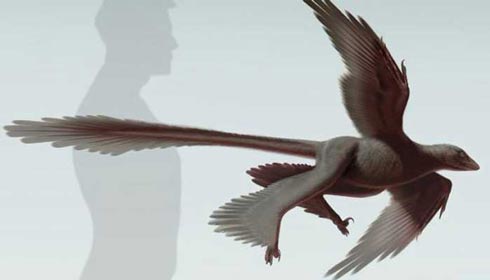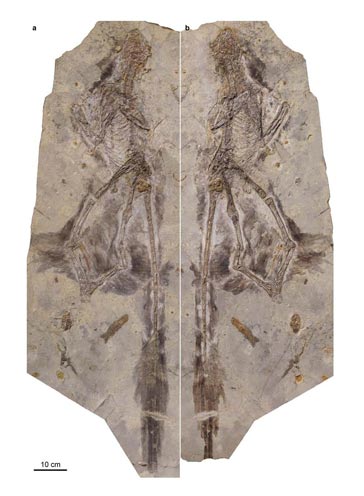Changyuraptor yangi – Let’s Not Get into Too Much of a Flap
And so on the 15th July, the paper on a new type of airborne dinosaur was published in the journal “Nature Communications”. The world was officially introduced to Changyuraptor yangi or to interpret the genus name, “long feathered raptor”. At about the size of a European Herring Gull (Larus argentatus), this newest member of the microraptorines, is the largest theropod dinosaur discovered to date with long pennaceous feathers attached to the hind limbs. At an estimated weight of around three to four kilogrammes, it is three times heavier than the largest species of Microraptor – M. zhaoianus (if indeed the fossils discovered to date do indeed represent three different species and not a single species but with extensive intra-specific variation), and four times heavier than that extant gull we mentioned earlier.
Changyuraptor yangi
Changyuraptor has other claims to fame. For example, its tail feathers are extremely long, measuring nearly thirty centimetres in length. The longest tail feather is around 30% the length of the entire skeleton.
However, for us at Everything Dinosaur, the announcement of this fossil find comes as no real surprise. The fossil material is from north-eastern China and it forms part of the amazing Jehol Biota which represents an Early Cretaceous ecosystem which has been preserved in strata that date from around 133 million years ago to 121 million years ago or thereabouts. All the microraptorine fossil material comes from this part of the world and the fossilised fauna and flora portray a habitat that had distinct seasons with a temperate forest habitat interspersed with large bodies of freshwater and swamps.
The Jehol Biota
The area teemed with life and with the finding of one predatory dromaeosaurid dinosaur with aerodynamic abilities (Microraptor), finding other examples of dinosaurs filling this ecological niche was always likely.
These hunters may not have caught their prey on the wing, but they probably spent a great deal of their lives high up in the tree canopy living an arboreal existence and stomach content analysis from Microraptor specimens indicate that these dinosaurs, closely related to the likes of Velociraptor, ate small mammals, lizards and even primitive birds. One poor unfortunate perching bird seems to have been swallowed whole.
An Illustration of Changyuraptor yangi (Silhouette of Person shows Scale)
Picture credit: S. Abramowicz
The international team of scientists behind the scientific paper, such as Luis M. Chiappe (Natural History Museum of Los Angeles County), Michael Habib (University of Southern California), Gang Han, Shu-An Ji, Xueling Liu and Lizhuo Han (Bohai University, Liaoning Province), in collaboration with colleagues based in New York and South Africa have described the beautifully preserved fossil material and then analysed this animal’s flight characteristics. Why, for example, did this “four-winged terror” have such long feathers on its tail?
The Holotype Fossil Material (C. yangi)
Picture credit: Nature Communications
Weighing Four Kilogrammes
At 1.32 metres in length and weighing close to four kilogrammes, taking to the air may not have been too much of a problem for our feathered friend here. Especially if this dinosaur launched itself from the branches of trees and glided around. However, controlling itself in flight and coming into land may have been somewhat more difficult for such a heavy, large-bodied animal.
The international research team examined the aerial competency of Changyuraptor and concluded that the tail may have acted as a pitch control structure, reducing air speed and helping to ensure a safe landing. Those hind limbs with their feathers too, would have assisted with gliding and with the legs rotated down and underneath the body as it descended, then the feathers could have made effective air brakes, in a similar way to the “trousers” on Archaeopteryx.
To read an article on the feathered legs of Archaeopteryx: Feathers Evolved Before Flight – Archaeopteryx Had Feathered Trousers.
Dr Michael Habib (University of Southern California) stated:
“It makes sense that the largest microraptorines had especially large tail feathers, they would have needed the additional control.”
Dr Alan Turner of Stony Brook University (New York), a co-author of the paper added:
“Numerous features that we have long associated with birds in fact evolved in dinosaurs long before the first birds arrived on the scene. This includes things such as hollow bones, nesting behaviour, feathers…and possibly flight.”
Liaoning Province Fossils
Bone structure analysis undertaken concluded that this was a fully grown, mature animal that rivalled the largest pterosaurs known from Liaoning Province in size as it glided in the sky above this ancient Chinese landscape. The holotype material was found back in 2012 and since its discovery the notion that flight preceded the origin of Aves has been consolidated. Birds inherited flight characteristics from their near relatives the Dinosauria. For the time being we shall give the last word to Luis Chiappe:
“This new fossil documents that dinosaur flight was not limited to very small animals but to dinosaurs of a more substantial size. Clearly far more evidence is needed to understand the nuances of dinosaur flight but Changyuraptor is a major leap in the right direction.”








Very interesting find